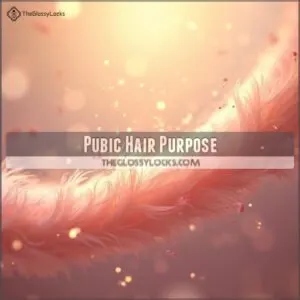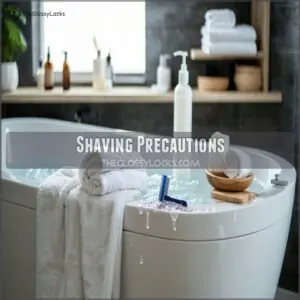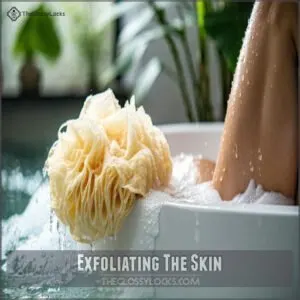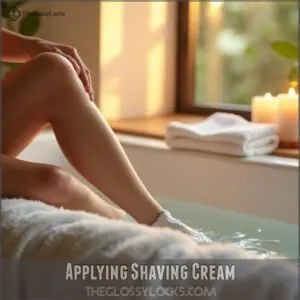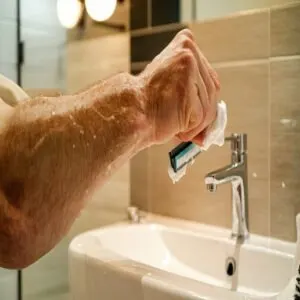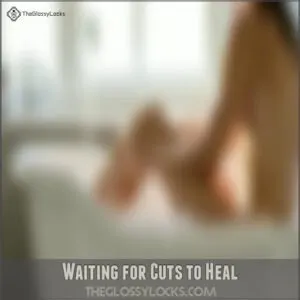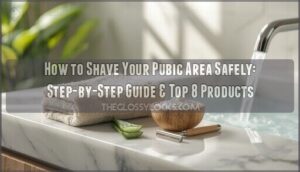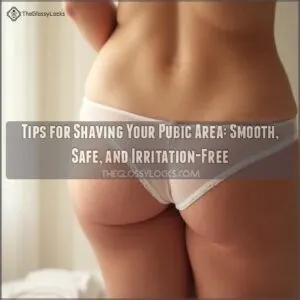This site is supported by our readers. We may earn a commission, at no cost to you, if you purchase through links.
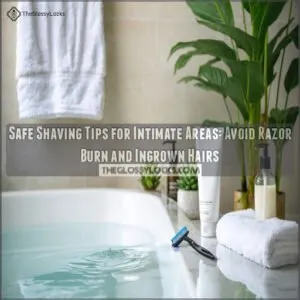
First, trim longer hairs with scissors before shaving. Always use a clean, sharp razor and a hydrating shaving cream to prevent nicks and irritation.
Exfoliate the area before shaving to prevent ingrown hairs, and soak in warm water for a few minutes to soften the hair and skin. Shave with light, gentle strokes in the direction of hair growth.
Rinse with lukewarm water, then apply a soothing, alcohol-free lotion. Avoid sex right after shaving to prevent infection.
For more tips and insights, keep reading!
Table Of Contents
- Key Takeaways
- Pubic Hair Purpose
- Shaving Precautions
- Safe Shaving Techniques
- Post-Shaving Care
- Alternative Hair Removal
- Frequently Asked Questions (FAQs)
- How to make a good intimate shave?
- How do I Shave my Intimate area?
- How to get a smooth shave in sensitive areas?
- How to shave private parts male safely and effectively?
- How often should you shave your pubic area?
- How do you shave without irritating your skin?
- Are there any health benefits to shaving your pubic hair?
- What are some pubic hair styles for guys?
- Is it normal for a man to shave his pubic hair?
- How do you shave your intimate area safely and neatly?
- Conclusion
Key Takeaways
- Soak, exfoliate, and trim before shaving. Use warm water to soften hair and skin, exfoliate to prevent ingrown hairs, and trim longer hairs with scissors or a bikini trimmer to ensure a smoother shaving process.
- Use the right tools and products. Opt for a clean, sharp razor, and a hydrating, pH-balanced shaving cream to prevent nicks and irritation. Go for alcohol-free, moisturizing aftershave lotions with soothing ingredients like aloe vera.
- Shave with gentle, light strokes in the direction of hair growth. This minimizes skin irritation and razor burn. Pay attention to your hair’s growth pattern, as it may change direction in different areas.
- Prioritize post-shave care. Rinse with lukewarm water, then apply a soothing, alcohol-free lotion. Avoid sexual activity for a while to prevent infection and give your skin time to heal.
Pubic Hair Purpose
Pubic hair isn’t just there for looks—it actually helps protect your skin from friction and irritation.
It also acts as a barrier against dirt, bacteria, and other potential irritants, keeping your intimate area safer.
Protection From Friction
Pubic hair is your skin’s natural shield, reducing friction in sensitive areas.
Without it, you’re more prone to skin irritation, intimate chafing, or friction burns during daily activities or intimacy.
Think of it as nature’s way of offering gentle care.
If shaving, make certain of proper technique to maintain friction reduction and smoother, safer results, and embrace shaving aftercare tips.
Prevention of Infection
To protect intimate areas, hygiene practices are key for infection prevention during shaving.
Cleanliness helps stop bacteria in their tracks.
- Wash up: Use warm water and a gentle cleanser for skin sanitation.
- Go antibacterial: Stick to clean razors and shaving cream with antibacterial measures.
- Post-shave care: Razor burn relief lotions help with bacterial prevention and skin irritation solutions.
Trapping of Pheromones
Your body’s natural scent markers, from pheromones to other chemical cues, play a surprising role in attraction science.
Pubic hair holds these human sexual chemicals, subtly boosting sexual confidence and hormone balance.
While prepping for intimate shaving tips, remember that pheromone signals might help enhance connection—not something razors can easily replace, and consider the value of Nature’s personal touch before shaving intimate areas.
Signaling Sexual Maturity
Pheromone signals play an intriguing role in relationships, quietly telling others about your hormone balance and sexual maturity.
These intimate cues, tied to pubic hair, can boost attraction through natural scents.
Curious about how? Here’s how pubic hair impacts sexual attraction:
- Traps pheromones for signaling.
- Enhances hormone-driven scents.
- Suggests maturity signs subtly.
- Strengthens intimate connections naturally.
- Adds depth to natural scents.
The provided list outlines the ways in which pubic hair influences attraction, from trapping pheromones to suggesting maturity signs.
Shaving Precautions
When shaving intimate areas, taking a few simple precautions can help you avoid discomfort and keep your skin healthy.
From trimming first to using a clean razor, these small steps make all the difference in preventing irritation and ingrown hairs.
Trimming Before Shaving
Before shaving, grab reliable trimming tools like a bikini trimmer to shorten hair to about 0.125 inches.
This preps your skin and makes smoother razor handling more likely.
Safe trimming on dry hair prevents clumping and makes the process easier.
Remember, shorter hair is kinder to your razor and reduces tugging.
For a smooth shaving technique, this is vital: take into account the direction of hair growth.
Here’s a quick comparison for better prep:
| Aspect | Ideal Practice | Why It Matters | Tools |
|---|---|---|---|
| Hair Length | Around 0.125 inches | Reduces pulling | Bikini Trimmer |
| Hair Texture | Dry | Avoids clumping | Scissors/Trimmers |
| Trimming Tools | Electric with guard setting | Prevents nicks | Electric Trimmer |
| Shaving Preparation | Short hair | Protects razor, skin | Clippers/Manual |
This approach guarantees a more efficient shaving process, emphasizing the importance of smooth shaving technique and proper shaving preparation.
Using Clean Razors
A clean blade means a happy shave.
For safe shaving practices, replace your razor blade every 5-7 shaves, and watch for signs like tugging or roughness that signal it’s time for a change.
Keep your razor storage spot dry and away from the shower to maintain rustfree blades.
Before each use, sanitize the blade with rubbing alcohol and rinse with hot water.
To guarantee the best shaving results and prevent issues like ingrown hairs, consider checking the razor blade maintenance guidelines regularly for safe shaving practices and a happy shave.
Avoiding Ingrown Hairs
Your skin deserves gentle hair follicle care to prevent those pesky ingrown hairs.
For effective bump prevention, start with proper exfoliation methods – gently scrub 2-3 times weekly.
When it’s time for sensitive skin shaving, always go with the grain and keep that blade lifted slightly to avoid digging too deep.
For extra ingrown hair prevention, wear loose cotton clothing and moisturize with pH-balanced products.
Preventing Razor Burn
Razor burn can make intimate areas feel like they’re on fire.
To keep your skin happy, never dry shave – it’s asking for trouble.
Always use warm water to soften hair follicles, and apply a thick layer of sensitive skin shaving cream.
Don’t press too hard or go over the same spot repeatedly.
Moving with the grain, not against it, helps prevent that dreaded post-shave burn and irritation.
Following proper prevent razor burn techniques is essential for maintaining healthy skin and avoiding ingrown hairs.
Safe Shaving Techniques
You’ll need a few key steps to guarantee a safe and comfortable shave in your intimate areas.
Start by soaking in warm water for 5-10 minutes, then use gentle, steady strokes with a sharp, clean razor in the direction your hair grows.
Soaking in Warm Water
Before reaching for that razor, take a 5-10 minute soak in warm water to properly prep your intimate areas.
The ideal water temperature (around body temp) softens hair and opens pores, making shaving safer and smoother.
You’ll notice your skin becoming more pliable – that’s exactly what you want.
For extra relaxation and hydration benefits, consider adding this step to your regular bath routine.
Utilizing a proper warm water treatment can substantially enhance the overall shaving experience, and provide extra relaxation and hydration benefits, making the skin more pliable, which is exactly what you want for a safer and smoother shave.
Exfoliating The Skin
Why does proper skin exfoliation matter before intimate shaving?
Dead skin cells can clog your razor and lead to irritation.
Using gentle exfoliation techniques helps prep your skin for a smoother shave while preventing ingrown hairs.
- Try a soft loofah with your favorite body wash for gentle scrubbing
- Use circular motions to lift dead skin without irritating sensitive areas
- Choose an alcohol-free exfoliant specifically designed for intimate areas
Applying Shaving Cream
Your next step in gentle care is choosing the right shaving cream – it’s your skin’s best friend.
For intimate areas, look for pH-balanced formulas with moisturizing ingredients like jojoba oil and aloe vera.
Apply a generous amount and massage it in for 60-90 seconds to create proper skin lubrication.
Understanding shaving cream application techniques is essential for a smooth and safe shaving experience.
| Cream Type | Key Ingredients | Benefits |
|---|---|---|
| pH-Balanced | Seaweed, Natural Oils | 24-hour hydration |
| Moisturizing | Jojoba, Avocado Oil | Prevents razor burn |
| Natural | Organic Elements | Suitable for sensitive skin |
| Protective | Soothing Agents | Guards against irritation |
Shaving in Hair Growth Direction
In line with proper shaving techniques, moving your razor in the direction of hair growth minimizes skin irritation and razor burn.
You’ll want to use gentle strokes while keeping the blade at a 30-degree angle against your skin.
Pay attention to your hair growth pattern – it might change direction in different areas.
If you’re unsure, run your fingers over the area to feel which way the hair naturally grows, following the hair growth pattern to ensure a smooth shave.
Post-Shaving Care
You’ll need to give your freshly shaved skin some TLC to prevent irritation and ingrown hairs.
After shaving, rinse with lukewarm water and apply an alcohol-free aftershave lotion to soothe your sensitive areas.
Rinsing With Lukewarm Water
When you’re done shaving, water temperature control is key. Stick with lukewarm water for your intimate area grooming.
Hot water can irritate freshly shaved skin, while cold water might shock your system.
Gently cleanse the area to maintain skin pH balance and rinse thoroughly to remove any leftover shaving cream.
A soft patting motion, rather than rubbing, helps with soothing irritation while keeping proper hydration methods in mind. Gently cleanse the area.
Applying Aftershave Lotion
After rinsing, soothe your skin with a moisturizing lotion, preferably one containing soothing aloe vera .
For best results, explore the numerous lotion aftershave benefits.
Lotion application helps prevent razor burn and ingrown hair by moisturizing skin and soothing irritation.
Here’s how:
- Pour a few drops into your palm.
- Rub your hands together.
- Gently massage the lotion onto your shaved skin.
- Confirm complete coverage.
- Allow it to absorb.
Choose aftershave choices free of alcohol and fragrances for ideal aftershave care, preventing infection.
Avoiding Sexual Intercourse
Hold your horses, partner! After shaving, it’s important to give your nether regions some time to recover.
Abstinence methods are key here, even if you’re feeling frisky, avoid sexual intercourse for a bit, this safe waiting period gives your skin time to heal and reduces the risk of infection.
It’s all about giving your body the healing time it needs, intimacy alternatives can guarantee you’re still having fun while keeping things safe.
It’s a simple yet effective way to practice genital shaving safety.
Waiting for Cuts to Heal
Waiting for any nicks or cuts to heal is essential for ideal wound healing and infection control.
Rushing things can lead to skin irritation, infection, and even scarring.
Here are some tips to speed up skin repair and healing:
- Keep it clean: Wash your hands before touching the area.
- Dry it right: Pat the area dry with a clean towel.
- Moisturize: Apply a thin layer of fragrance-free lotion to keep the skin supple.
- No scratching: Avoid the urge to scratch, as it may lead to scarring.
- Time is a healer: Give it time—let the skin repair itself.
Alternative Hair Removal
There are several alternative hair removal methods to choose from, each with its pros and cons.
From depilatory creams that dissolve hair to more permanent options like laser hair removal and electrolysis, you can explore these methods to find the best fit for your intimate area grooming needs.
Depilatory Creams
Depilatory creams, often known as hair-dissolving creams, offer a painless alternative to shaving.
These creams contain chemicals that react with hair, breaking it down for easy removal.
While quick and convenient, they can cause skin irritation and burning sensations due to the strength of the ingredients.
Always check the ingredients and make certain they’re suitable for intimate areas.
Patch tests are a must for shaving safety!
When considering hair removal methods, understanding best hair removing creams can help you make an informed decision about the most suitable option for your skin type and needs, especially with intimate areas and best hair removing creams.
Waxing and Sugaring
Waxing and sugaring are hair removal methods that provide longer-lasting results compared to shaving.
They involve pulling hair out from the root, which can be painful but guarantees smooth skin for weeks.
It’s important to prepare the skin properly before waxing or sugaring and to prioritize aftercare methods to reduce the risk of infection.
These techniques are popular for intimate areas as they effectively remove hair while exfoliating the skin.
Make certain you visit a licensed professional for safe and hygienic hair removal.
For effective hair removal, using proper waxing kits is essential to achieve desired results.
Laser Hair Removal
Laser hair removal is a popular alternative to shaving and waxing.
It’s more permanent, offering long-lasting results with fewer touch-ups.
Here are some key points about laser hair removal:
- Laser Costs: It can be expensive, requiring multiple sessions with a professional.
- Hair Regrowth: Results in smooth skin for weeks or even months.
- Skin Types: Ideal for people with thick, dark hair and light skin.
- Removal Sessions: Each session takes 5-20 minutes, targeting hair follicles with selective photothermolysis.
- Follicle Damage: Lasers destroy hair follicles to prevent regrowth.
Electrolysis Treatments
Electrolysis is the only FDA-approved permanent hair removal method.
It involves inserting a thin wire into each hair follicle, zapping it with an electric current, and then tweezing out the hair.
While it’s effective for various skin and hair types, it can be time-consuming and costly, with potential skin reactions like redness and irritation.
Multiple treatment sessions are needed, and it may be painful, which are factors to consider for electrolysis cost and its permanence.
Weigh the electrolysis cost and permanence against other hair removal techniques.
Frequently Asked Questions (FAQs)
How to make a good intimate shave?
First off, prep is key.
Soak in warm water, exfoliate, and trim.
Then, use a fresh razor and shaving cream.
Shave with the grain, rinse often, and pat dry.
Finish with a soothing, fragrance-free lotion.
How do I Shave my Intimate area?
First, trim with clippers, then soak in warm water for 5–10 minutes.
Lather up, and use a fresh, clean razor.
Shave with the grain, rinse, and pat dry.
Finish with a soothing, fragrance-free lotion.
How to get a smooth shave in sensitive areas?
Getting a smooth shave in sensitive areas takes prep and patience.
Soak in warm water, exfoliate, and trim first.
Use a fresh razor, and shave with the grain, rinse often, and take it slow.
How to shave private parts male safely and effectively?
Here’s a step-by-step guide to safely and effectively shaving your private parts:
- Soak in warm water for a few minutes to soften skin and hair.
- Trim with clippers first, then use a fresh razor to shave, rinsing it often.
- Shave with the grain, applying light pressure.
- Rinse, pat dry, and apply a gentle aftershave balm.
How often should you shave your pubic area?
So, you’ve taken the plunge and shaved your pubes – but how often should you repeat this ritual?
Well, it depends, if you’re a daily shaver, you’ll need to get friendly with your razor every 1-3 days to keep things smooth.
How do you shave without irritating your skin?
Soaking in warm water preps your skin for shaving.
Exfoliate, then use a moisturizing shaving cream.
A sharp, clean razor prevents clogging and infection.
Shave with the hair growth direction.
Rinse, pat dry, and apply an alcohol-free aftershave.
Are there any health benefits to shaving your pubic hair?
Shaving your pubic hair is a personal choice.
While it doesn’t offer the health benefits of pubic hair, like protection and reduced friction, it can make you feel cleaner, neater, and more comfortable.
What are some pubic hair styles for guys?
There are a few popular pubic hair styles for guys: the landing strip, the triangle, and the full bush.
Each style has its own benefits and drawbacks, so choose what suits you.
Is it normal for a man to shave his pubic hair?
It’s a free world, and each to their own – there’s no one-size-fits-all regarding personal grooming.
More and more men are choosing to shave down there, so if you want to, go for it!
How do you shave your intimate area safely and neatly?
First off, trim with clippers, then soak the area in warm water for a few minutes.
Use shaving cream and a sharp, clean razor, shaving with the hair growth.
Rinse with lukewarm water, pat dry, and apply a gentle lotion.
Conclusion
There’s a reason for the adage "no pain, no gain," but in regards to shaving intimate areas, a little knowledge can help you avoid a world of hurt.
With these safe shaving tips, you can say goodbye to razor burn and ingrown hairs.
Follow these precautions, techniques, and aftercare steps for a smooth, irritation-free experience.
Keep these tips in mind to make certain that your intimate shaving routine is both effective and safe and comfortable.
- https://www.philips.co.uk/c-e/pe/beauty-tips-for-women/hair-removal/hair-removal-methods/how-can-you-shave-your-intimate-area.html
- https://health.clevelandclinic.org/want-a-smooth-safe-shave-every-time-try-these-10-tips
- https://www.philips.co.in/c-e/beauty-tips-for-women/hair-removal-tips/hair-removal-methods/how-to-shave-intimate-area.html
- https://she.shavent.store/en/blogs/news/die-ultimative-anleitung-fur-eine-sichere-intimrasur-bei-frauen
- https://www.teenvogue.com/story/how-to-shave-your-pubic-area-safely

